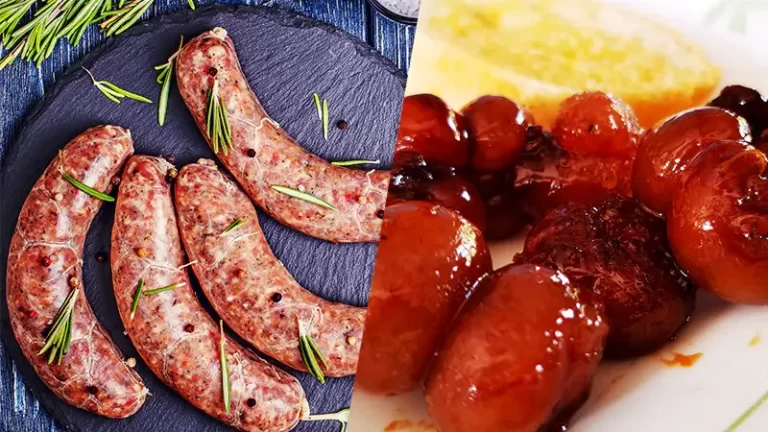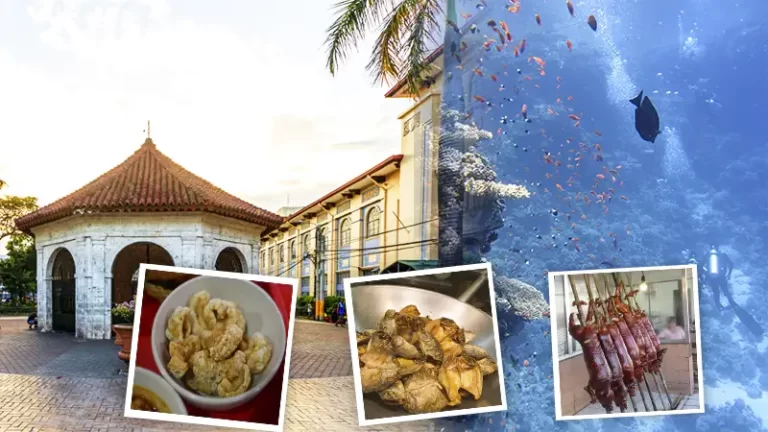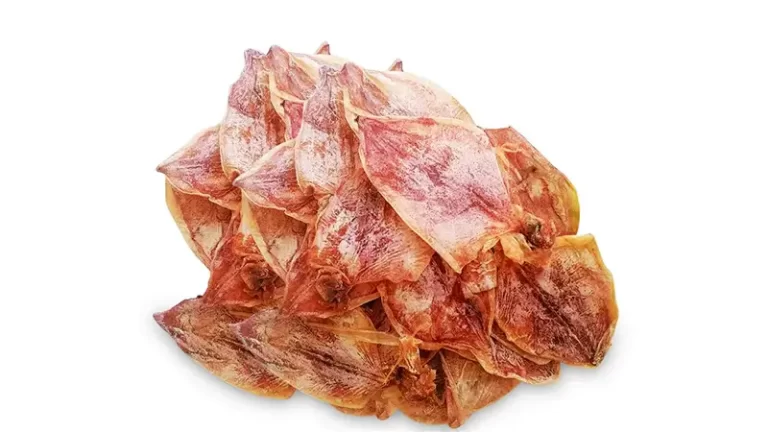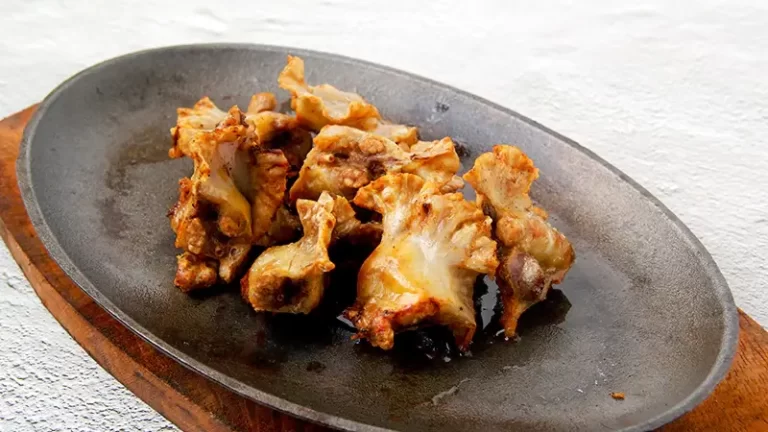The chorizo – a pork sausage enjoyed in various parts of the world, including North and South America, Mexico, Spain, and Europe, among others. Here in the Philippines, we have our fair share of longanisas and chorizos, too. Arguably, one of the most famous chorizos in the country is Chorizo de Cebu.
But, what is Chorizo de Cebu? How do you cook and eat it? Can you prepare it at home? Keep reading to discover the answers to these questions and more!
What is Chorizo
What is chorizo?
Chorizo; similar to but distinct from Portuguese chouriço, is a type of pork sausage originating from the Iberian Peninsula.
In Europe, chorizo is a fermented, cured, smoked sausage, which may be sliced and eaten without cooking, or added as an ingredient to add flavor to other dishes. Elsewhere, some sausages sold as chorizo may not be fermented and cured, and require cooking before eating. Spanish chorizo and Portuguese chouriço are distinctly different sausages, despite both getting their smokiness and deep red color from dried, smoked, red peppers (pimentón / pimentão).
Chorizo is eaten sliced in a sandwich, grilled, fried, or simmered in liquid, including apple cider or other strong alcoholic beverages such as aguardiente. It is also used as a partial replacement for ground (minced) beef or pork.
The word chorizo probably comes from the Late Latin salsīcia ‘salted’, via the Portuguese souriço; it is a doublet of the Spanish word salchicha ‘sausage’, which was transmitted through Italian salsiccia.
What is Chorizo de Cebu?
There are many different types and varieties of chorizos in the world, and even in the Philippines. In the country, arguably one of the most popular varieties is the Chorizo de Cebu.
Chorizo de Cebu, also known as longganisa de Cebu, is a Filipino pork sausage originating from Cebu. It is a type of hamonada (sweet) longganisa.
They are distinctively red in color due to the use of achuete seeds. Each link is also usually spherical in shape. It is made from ground lean pork, ground pork fat, salt, saltpeter, sugar, anise liqueur (anisado), paprika, black pepper, garlic, and chilis to taste in a hog casing. It can also be made without the casing. They are usually fried or grilled and eaten with white rice, puso, or garlic rice for breakfast.
Further, compared to other chorizos in the country, Chorizo de Cebu also has a big difference in flavor – while it’s primarily sweet, there is an extra spice kick due to the hot paprika and chilies plus a floral taste from the anise liqueur.
Chorizo de Cebu is consumed quite differently compared to the other longganisas too, since most of them are used as ulam (viand) with rice; on the other hand, this Cebuano sausage is usually paired with puso.
How to Cook Chorizo de Cebu
While there are several ways to cook Chorizo de Cebu, broiling, pan-frying, and grilling are three of the best ways to ensure a flavorful, tasty outcome. Whether you’re preparing a quick dinner for your family or a barbecue cookout feast for a larger group, these three cooking methods are sure to get you delicious and golden-brown chorizo that everyone will enjoy!
Broiling
Did you know that you can cook Chorizo de Cebu in the oven? Broiling chorizo in the oven is an easy way to expose it to high, direct heat while locking in its flavor. So, if you’re looking for a way to cook Chorizo de Cebu without having to monitor it continually, try these three steps to broiling.
Like most sausages, you can bake chorizo in the oven. However, how long you bake it depends on whether they’re whole sausages, chunks, or smaller pieces.
- Preheat the oven. Get your oven ready to broil by turning on its broiling setting and waiting for it to heat up.
- Put chorizo on the broiler rack. Place the chorizo on the broiler rack at least 7 – 9 inches below the heating element.
- Broil the chorizo. Let the chorizo broil for around 13 – 15 minutes on each side, until the meat is golden brown all the way around. Remove the chorizo from the oven and dig in!
- Pan-Frying
If you want to slice, sear, or cook your Chorizo de Cebu like ground beef, the stovetop is your best bet.
- Heat a pan. Place a pan over medium heat. Cooking chorizo slowly over low heat will allow its flavors to fully develop, but medium heat works almost as well if you’re in a time crunch. Avoid using high heat, because it will burn the chorizo links without fully cooking them through.
- Cover and cook. Put a lid over the pan and allow the chorizo links to cook for about 10 – 12 minutes, turning them frequently.
- Remove cover and keep cooking. Take off the lid and continue cooking the chorizo for an additional 5 – 7 minutes or until golden brown.
- Grilling
Do you love barbecues? If you enjoy cooking outdoors, grilling Chorizo de Cebu is a great way to get some fresh air while giving the chorizo a smoky flavor.
- Preheat your grill. For a gas grill, turn the burners to high heat. If you’re using a charcoal grill for extra smoky flavor, fill the grill with briquettes and light them until they become hot with a light covering of ash. Then, transfer the hot briquettes to the bottom grill grate and set the top grill grate on the grill.
- Place the chorizo. Once the grill is hot, put your chorizo on the grill. Space the links out evenly, leaving about an inch between them, to promote good air circulation and allow them to cook more evenly.
- Trap the heat. Keep the grill hot by putting its lid over the evenly spaced chorizo links.
- Cook through. How long should you cook chorizo? Grilling chorizo typically takes around 15 – 20 minutes. Use tongs to rotate the sausages every few minutes, so they become an appealing golden-brown shade on all sides.
- Let the chorizo rest. After you’ve finished grilling your chorizo, place it on a cutting board or plate to rest for a few minutes before serving. As the chorizo links rest, cover them with aluminum foil to keep them warm and encourage the juices to redistribute within the meat. Once the chorizo has finished resting, serve it up and enjoy!
Chorizo de Cebu Recipe
Want to try making some homemade chorizos? Here are some Chorizo de Cebu recipe ideas you can try!
Ingredients:
- 1.2 kilograms ground pork
- 1 tablespoon coarse salt
- ½ teaspoon Prague powder #1
- 1 teaspoon sodium phosphate
- ¼ cup cold water
- ¼ cup TVP (Textured Vegetable Protein)
- 1 tablespoon Isolate
- ½ teaspoon Carrageenan
- 2 tablespoon sugar
- 6 tablespoon garlic, minced
- 2 tablespoon paprika (for color)
- 3 tablespoon Anise Wine/Anisado Wine
- 1 tablespoon ground black pepper
- 2 tablespoon pineapple juice
- ½ teaspoon meat enhancer (optional)
Instructions:
- In a large bowl that can fit inside your fridge, combine salt, Prague powder, phosphate, Anise liquor, and water.
- Add the Textured Vegetable Protein, Isolate, and Carrageenan.
- Next, add-in ground pork, sugar, garlic, paprika, ground black pepper, pineapple juice, and meat enhancer. Mix thoroughly with a large spoon or use plastic gloves to combine it well with hands.
- Let it marinate in the refrigerator not more than 12 hours. (Note: Make sure to list down the time, because mixture will turn sour if marinated for more than the prescribed time in the recipe).
- Wrapping Chorizo de Cebu: Shape it in small round chorizos and wrap each chorizo. It is best to use sausage casings. But if it’s not available, you can just shape the mixture over a wax or parchment paper.
- Once you’re done, the chorizo is ready for broiling, frying, or grilling.
- Enjoy your homemade Chorizo de Cebu!
Different Ways to Prepare and Use Chorizo de Cebu
Feeling a little more adventurous? Whether you make chorizo the star of the dish or use it as a crispy, flavor-packed addition, the possibilities with this humble pork sausage are endless!
Here are some different ways to prepare, use, and enjoy Chorizo de Cebu:
Ingredients:
- 4 x 150g raw chorizo sausages
- 1 onion, chopped
- 2 garlic cloves, crushed
- 1 tsp each smoked paprika, ground cumin
- 1⁄2 tsp chili flakes
- 400g can chopped tomatoes
- 400g can red kidney beans
- 2 ripe avocados, cut into wedges
- 500g mixed tomatoes, chopped
- 1 jalapeno chili, thinly sliced
- 2 tbs white wine vinegar
- 2 tbs extra virgin olive oil
- 1 tsp Tabasco
- Corn chips, sour cream, micro coriander (or coriander), lime wedges to serve
Instructions:
- Squeeze the meat from the chorizo casings. Add to a cold frypan, then place over medium heat. When it begins to sizzle, and the fat has started to render, cook for 2-3 minutes.
- Add the onion and cook for a further 2 minutes or until slightly softened. Add the garlic and spices and cook for a further 5 minutes, then add the tomatoes and 1 cup (250ml) water.
- Simmer for 10 minutes until reduced. Stir through the beans to warm through.
- To make the salsa, place the avocado, tomatoes and jalapeno in a bowl. Combine the vinegar, oil and Tabasco, then pour over the salsa.
- Top chorizo mixture with sour cream and micro coriander. Serve with corn chips and lime wedges.
Ingredients:
- 200g spaghetti
- 1 tbs extra virgin olive oil
- 2 x 100g dried chorizo, finely chopped
- 1 garlic clove, crushed
- 1 sprig rosemary, finely chopped
- 2/3 cup (50g) grated parmesan
- 2 tsp white vinegar
- 2 eggs
- 1/2 cup chopped flat-leaf parsley leaves
Instructions:
- Bring a large saucepan of water to the boil over high heat.
- Place chorizo and oil in a cold frypan, then place over medium heat. Once it begins to sizzle and the fat starts to render, cook, stirring, for 6 minutes or until crisp.
- Meanwhile add the pasta to the water and cook until al dente.
- Add the garlic and rosemary to the chorizo and cook for 30 seconds until fragrant then remove from the heat.
- Use tongs to remove pasta from the water and place into the pan of chorizo, allowing excess water to follow along with 1/3 cup water.
- Return the water to just below a simmer. Add the vinegar then gently lower in the two eggs using two small bowls. Poach for 2 minutes for very soft eggs.
- Toss the pasta with half the parmesan and a little more water if needed and parsley and divide between bowls. Top with the eggs.
- Sprinkle with extra parmesan, parsley and cracked pepper.
Ingredients:
- 2 tbs olive oil
- 250g fresh chorizo sausages (from selected butchers), skins removed
- 1 rosemary sprig, leaves picked
- 3 garlic cloves, crushed
- 1 each carrot, onion and celery stalk, finely chopped
- 250g each pork and veal mince
- 1/4 cup (70g) tomato paste
- 2/3 cup (165ml) red wine
- 1 1/2 cups (375ml) beef stock
- 400g can Ardmona Diced Tomatoes
- 1.25L (5 cups) chorizo ragout
- 200g dry lasagne sheets
- 250g mascarpone
- 2 buffalo mozzarella balls, sliced
- 1/4 cup (30g) finely grated parmesan
- Basil leaves, to serve
Instructions:
- For the ragout, heat the oil in a large, deep frypan over medium heat, and add chorizo, rosemary, garlic, carrot, onion and celery. Cook, breaking up chorizo with a wooden spoon and stirring occasionally, for 8 minutes or until chorizo is browned and vegetables are softened.
- Increase heat to high and add the pork and veal mince. Cook, breaking up with a wooden spoon, for 10 minutes or until browned. Add tomato paste and cook, stirring, for 5 minutes or until caramelized.
- Add the wine and simmer for 2 minutes, then add the stock and tomato. Bring to the boil, then reduce heat to low and gently simmer, stirring occasionally, for 1 hour or until sauce is thick and rich.
- Cool, then store refrigerated for up to 5 days or freeze for up to 3 months.
- For the lasagna, place a small amount of ragout in base of a large ovenproof frypan. Add 3 lasagna sheets, then pour over remaining ragout.
- Stir through mascarpone. Break up remaining lasagna sheets and push into the sauce. Top with mozzarella.
- Cover pan and cook over medium-low heat for about 12 minutes or until the pasta is al dente.
- Heat the grill to high. Scatter lasagna with parmesan and grill for 1-2 minutes or until golden. Serve scattered with basil.















